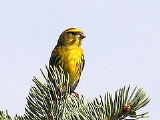
European Serin
Encyclopedia
The European Serin, or just Serin (Serinus serinus) is the smallest European species of the family of finch
es (Fringillidae) and is closely related to the Canary. Its diet consists mainly of a combination of bud
s and seed
s.
It breeds across southern and central Europe
and north Africa
. Southern and Atlantic coast populations are largely resident, but the northern breeders migrate
further south in Europe for the winter. Open woodland and cultivation, often with some conifers, is favoured for breeding. It builds its nest in a shrub or tree, laying 3-5 eggs. It forms flocks outside the breeding season, sometimes mixed with other finches.
The food is mainly seeds, and, in the breeding season, insects. This small serin
is an active and often conspicuous bird.
Finch
The true finches are passerine birds in the family Fringillidae. They are predominantly seed-eating songbirds. Most are native to the Northern Hemisphere, but one subfamily is endemic to the Neotropics, one to the Hawaiian Islands, and one subfamily – monotypic at genus level – is found...
es (Fringillidae) and is closely related to the Canary. Its diet consists mainly of a combination of bud
Bud
In botany, a bud is an undeveloped or embryonic shoot and normally occurs in the axil of a leaf or at the tip of the stem. Once formed, a bud may remain for some time in a dormant condition, or it may form a shoot immediately. Buds may be specialized to develop flowers or short shoots, or may have...
s and seed
Seed
A seed is a small embryonic plant enclosed in a covering called the seed coat, usually with some stored food. It is the product of the ripened ovule of gymnosperm and angiosperm plants which occurs after fertilization and some growth within the mother plant...
s.
Description
It is a small short-tailed bird, 11–12 cm in length. The upper parts are dark-streaked greyish green, with a yellow rump. The yellow breast and white belly are also heavily streaked. The male has a brighter yellow face and breast, yellow wing bars and yellow tail sides. The song of this bird is a buzzing trill, very familiar in Mediterranean countries.It breeds across southern and central Europe
Europe
Europe is, by convention, one of the world's seven continents. Comprising the westernmost peninsula of Eurasia, Europe is generally 'divided' from Asia to its east by the watershed divides of the Ural and Caucasus Mountains, the Ural River, the Caspian and Black Seas, and the waterways connecting...
and north Africa
Africa
Africa is the world's second largest and second most populous continent, after Asia. At about 30.2 million km² including adjacent islands, it covers 6% of the Earth's total surface area and 20.4% of the total land area...
. Southern and Atlantic coast populations are largely resident, but the northern breeders migrate
Bird migration
Bird migration is the regular seasonal journey undertaken by many species of birds. Bird movements include those made in response to changes in food availability, habitat or weather. Sometimes, journeys are not termed "true migration" because they are irregular or in only one direction...
further south in Europe for the winter. Open woodland and cultivation, often with some conifers, is favoured for breeding. It builds its nest in a shrub or tree, laying 3-5 eggs. It forms flocks outside the breeding season, sometimes mixed with other finches.
The food is mainly seeds, and, in the breeding season, insects. This small serin
Serín
Serín is a district of the municipality of Gijón / Xixón, in Asturias, Spain.The population of Serín was 309 in 2004Serín is located on the western area of Gijón / Xixón, and borders the Asturian municipalities of Llanera, Corvera and Carreño.Barrios & Places:-External links:* - Gijón / Xixón...
is an active and often conspicuous bird.
External links
- European Serin videos, photos & sounds on the Internet Bird Collection
- Ageing and sexing (PDF) by Javier Blasco-Zumeta
- Oiseaux Photographs, text, map.

